Yes, I know, I am living in the past. I remember when I could buy a Shutterbug in the supermarket, read through page after page of small-text advertisements, and call (with my land line) B&H, Freestyle, or Calumet and order Kodak Ektar 25 film. Residents outside the United States had equivalent camera magazines or tabloids with pages of photography advertising. In a big city, a serious camera store may have stocked Ektar 25, but it was a low-volume product and most likely you needed to order it from one of the major mail-order suppliers. This is a short article about how I used my last two rolls of this quirky but amazing emulsion.
Kodak Ektar 25
Eastman Kodak advertised Ektar 25 as the finest-grain color negative film ever made when it was introduced in 1988. A New York Times article noted:
“Ektar 25 is not for everyone. Its ability to produce good-looking enlargements is offset by its slow speed and whisker-thin exposure latitude. Because of this, Kodak recommends that it be used only in single-lens-reflex cameras, not in point-and-shoots. (One reason is that most point-and-shoot cameras are equipped to ”read” ISO speeds only as slow as 100.) Still, for serious photographers, it’s a dream come true.”
I remember advertising which stated, “For SLR 35mm cameras.” Did I sin when I used the 135 size in my Leica rangefinder or the 120 size in my Rolleiflex twin-lens? It had a unique color palette and was hard to use, but was perfect for urban decay photography, especially in gloomy light. Kodak discontinued the 35mm Ektar films in 1994 and replaced them with Royal Gold versions. The 25 was the same emulsion, just with a new name. Some of my 1993-1994 frames from Vicksburg and 2005 frames from a historic railroad depot in Mound, Louisiana, show how vibrant this film was in its prime.
One reference said Royal Gold 25 was discontinued in 1998 (How time flies! That was over two decades ago. Ugh). Regardless, I keep hoping to find rolls of Ektar 25 or Royal Gold 25 that have been frozen and are still in good condition. In 2016-2017, I used the last of my rolls from the freezer, and they were still fine. Some of my photographs from the small towns of Church Hill and Avon demonstrate the film’s capabilities. I bought two rolls of 120 size from an eBay fellow who had no information about the storage conditions. One was spoiled, so I discarded the other roll. Then I bought three rolls from another fellow who claimed they had been frozen. One was fine. Yes!
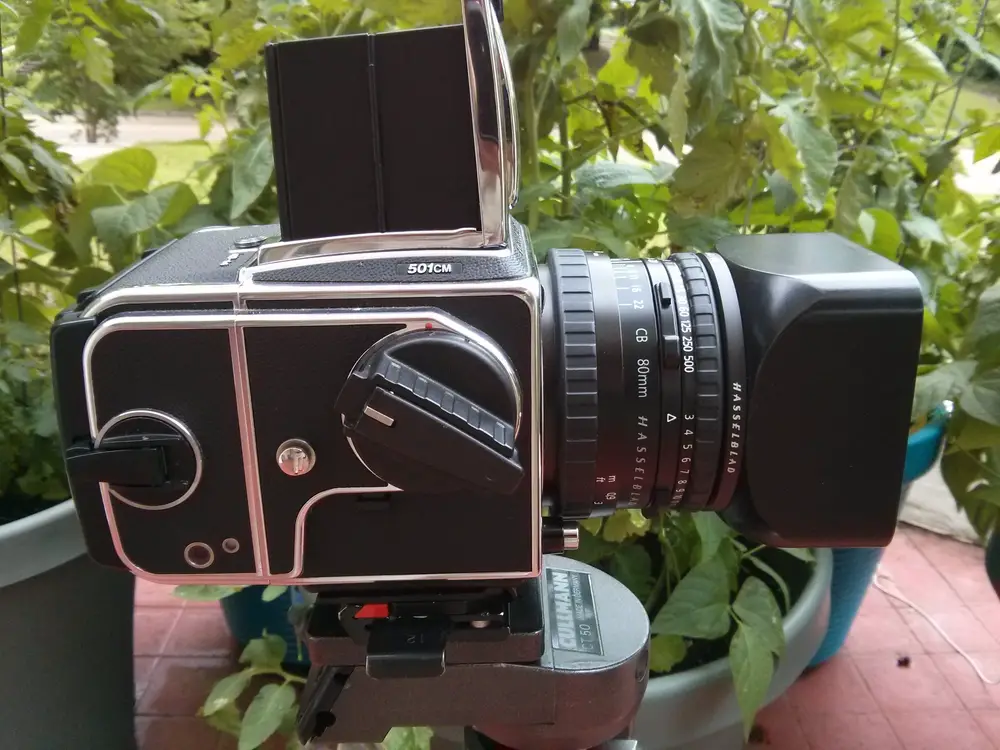
Hasselblad 501CM
The Hasselblad 501CM was the last version of the venerable V series of mechanical 6×6 medium format cameras. Hasselblad sold it as a kit with the Acute Matte finder screen, an A12 film back, fold-up finder, and the 80mm f/2.8 Planar CB lens. I bought mine used in 2017 in excellent condition. Mine did not need a cleaning or overhaul. (Warning: some unscrupulous (scum) ePrey sellers take the Acute Matte screen out and sell it on the side. Then they substitute one of the older and dimmer earlier screens, hoping the buyer will not notice. To replace the Acute Matte screen can cost $300 or so.) The 501CM has the gliding mirror, which is a benefit with long focal length lenses. The 80mm CB lens is a 6-element optic, in contrast to the older 80mm 7-element Planar. Whether the new lens is “better” or “worse” or “sharper” I cannot say. Ming Thein wrote an excellent overview of the 501CM if you want more details – there is also a guide to the V-System on Emulsive.
Since buying my 501CM, I added 50mm Distagon and 250mm Sonnar lenses. In the USA, these were surprisingly inexpensive considering their beautiful craftsmanship. They were cheaper than mass-market zooms sold for digital cameras. After buying hoods, some Bay 50 and Bay 60 filters, and a tripod-coupler, I have temporarily assuaged my GAS and need to take pictures.
In March, I used the remaining two rolls of Ektar 25 to record flood waters. These frames are from my 501CM, all tripod mounted, film exposed at EI=20. I scanned the negatives with a Minolta Scan Multi medium format film scanner. Trouble: these rolls were shifted in color. But by using the grey pointer/dropper in the software, I could partly recover the colors. I typically placed the pointer on grey pavement or metal siding. The Silverfast Ai software does not have an Ektar 25 profile, so I used the Royal Gold 100 profile, which may not be optimum. Sadly, I have concluded, no more experiments with the 25. It is over, time to move on, possibly to Ektar 100.
Examples from the Mississippi Delta
These examples are from Vicksburg and the southern part of the Mississippi Delta, specifically the region known as the Yazoo backwater.
Let me digress with a short explanation of the hydrology of the region and why you see so much water. Levees (or dikes) line the Mississippi River all the way from central Missouri to the mouth of the river in the Gulf of Mexico (well south of New Orleans). The purpose of the levees is to prevent flooding of farmland and towns in the Midwest when the river is high. The Yazoo River is a tributary of the Mississippi and drains west central Mississippi, the broad flat alluvial plain known as the Mississippi Delta (the same Delta famed for Blues music).
Problem no. 1: If the Mississippi River is in flood, the water will back up the Yazoo and inundate farmland and towns. Therefore, the US Army Corps of Engineers (USACE) built levees along the Yazoo. The USACE installed flood control gates into the levee at a place called Steele Bayou, near the town of Redwood. The USACE closes the gates to prevent those flood waters from rolling over the farms of the southern Delta.
Problem no. 2: If there has been heavy local rain in west central Mississippi, the streams and bayous of the Delta rise. But if the Mississippi is simultaneously in flood, the Steele Bayou gates are closed. Therefore, there is no place for the local runoff to drain out, and the water rises and rises behind (or north of) the gates. March of 2019 was one of these times when both the Mississippi River was in flood and there had been torrential rain in the state of Mississippi – for weeks. The Yazoo backwater experienced the greatest inundation since the 1973 flood.
Complexity: In 1941, Congress authorized the Corps of Engineers to install pumps near Steele Bayou to pump Yazoo backwater water up and over the levee into the Yazoo River. These pumps would be some of the largest on earth and today would cost over $300 million. Congress, farmers, and environmentalists have been fighting over the infamous pumps since the 1940s. You see where this is going….
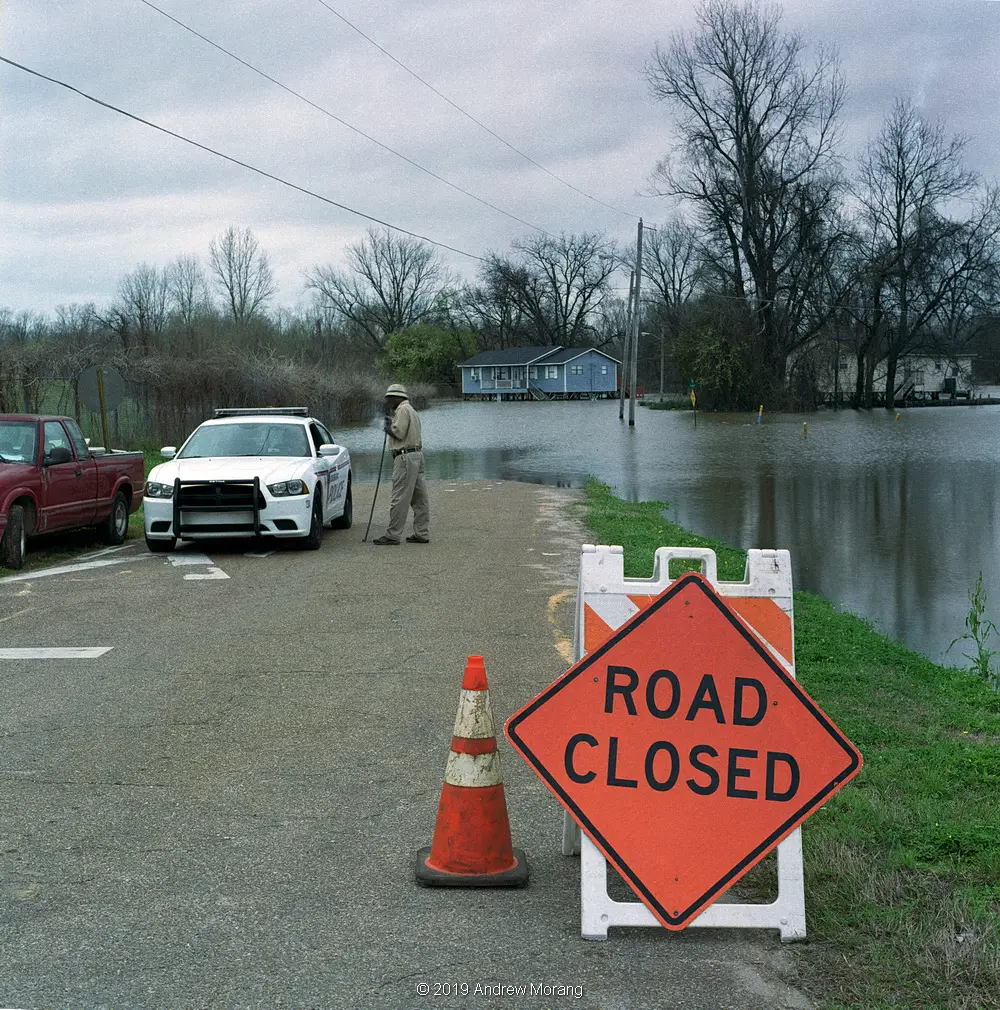
The Ford subdivision in Vicksburg often floods. Over the last few years, the City of Vicksburg purchased and demolished many homes under a program sponsored by the Federal Emergency Management Administration (FEMA), but some residents have remained. The Vicksburg policeman is on duty to prevent looting.
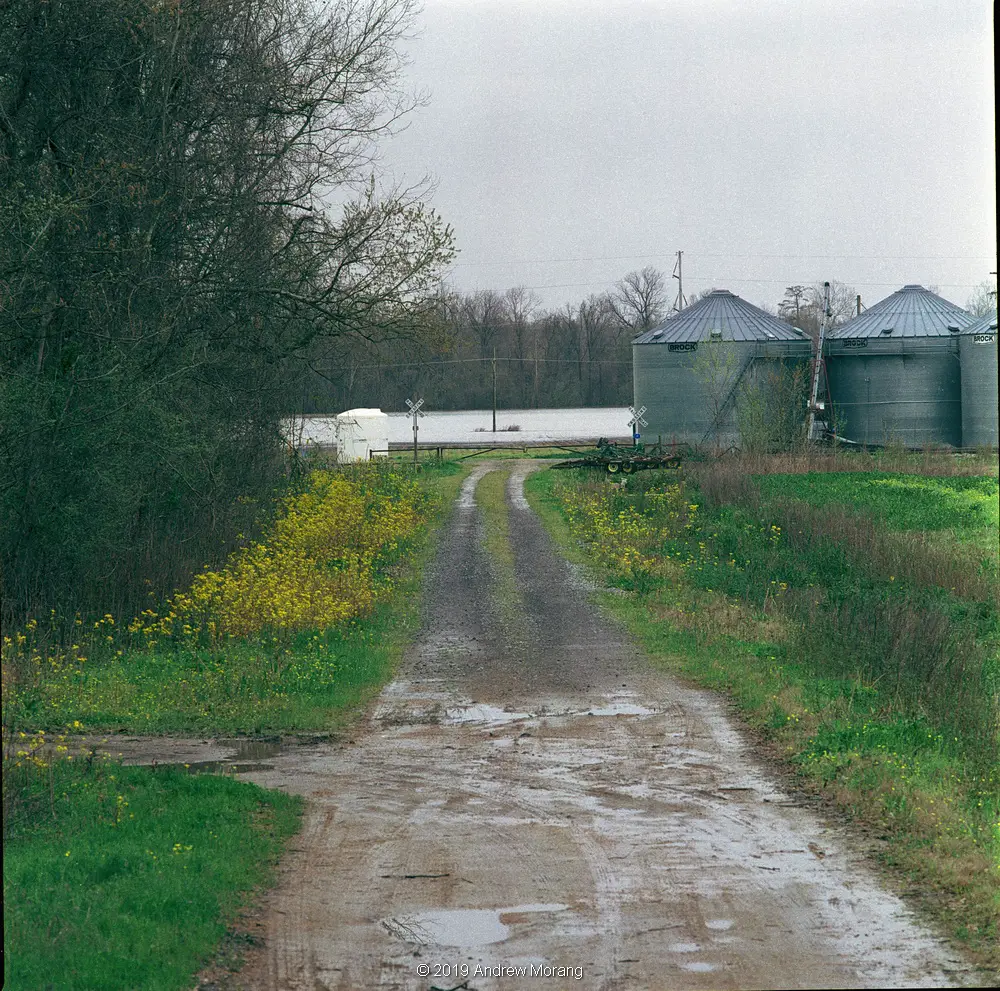
Further north, the terrain east of the railroad tracks is usually dry because the railroad embankment serves as a form of levee. But to the west, the farm fields are completely inundated.
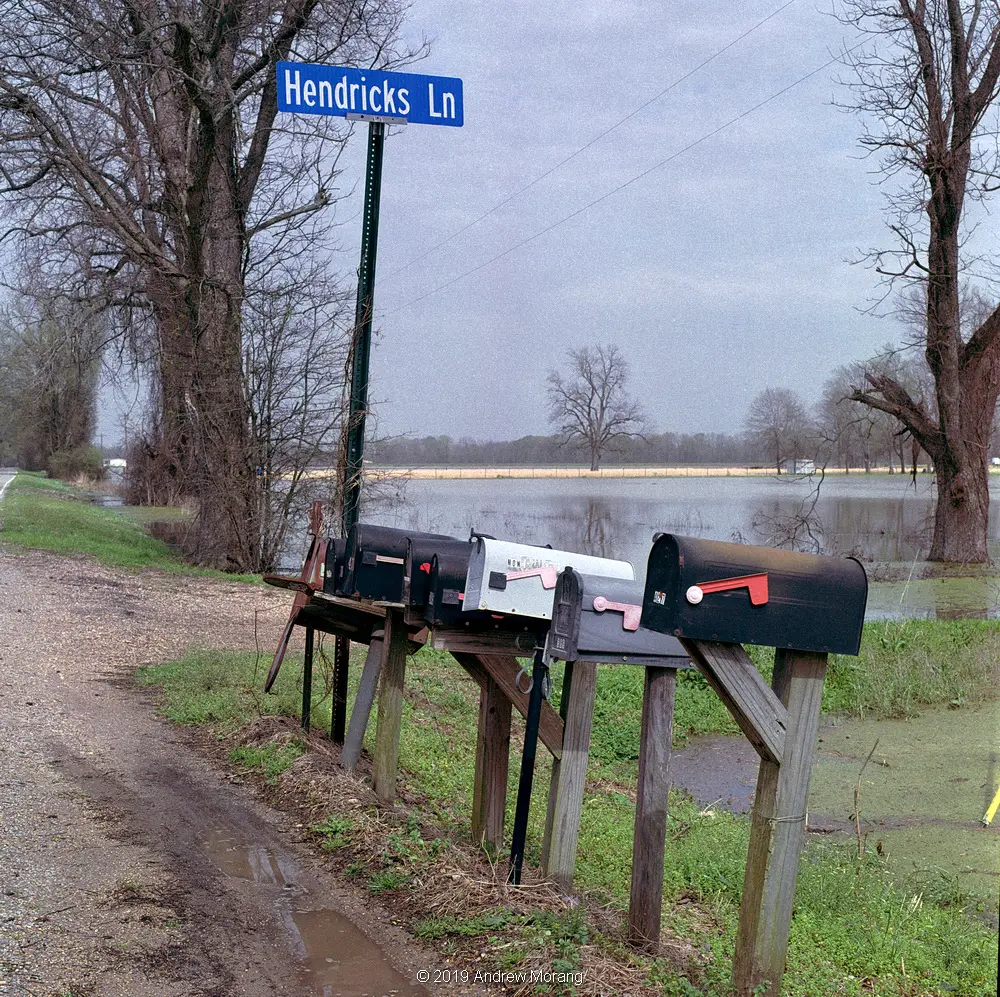
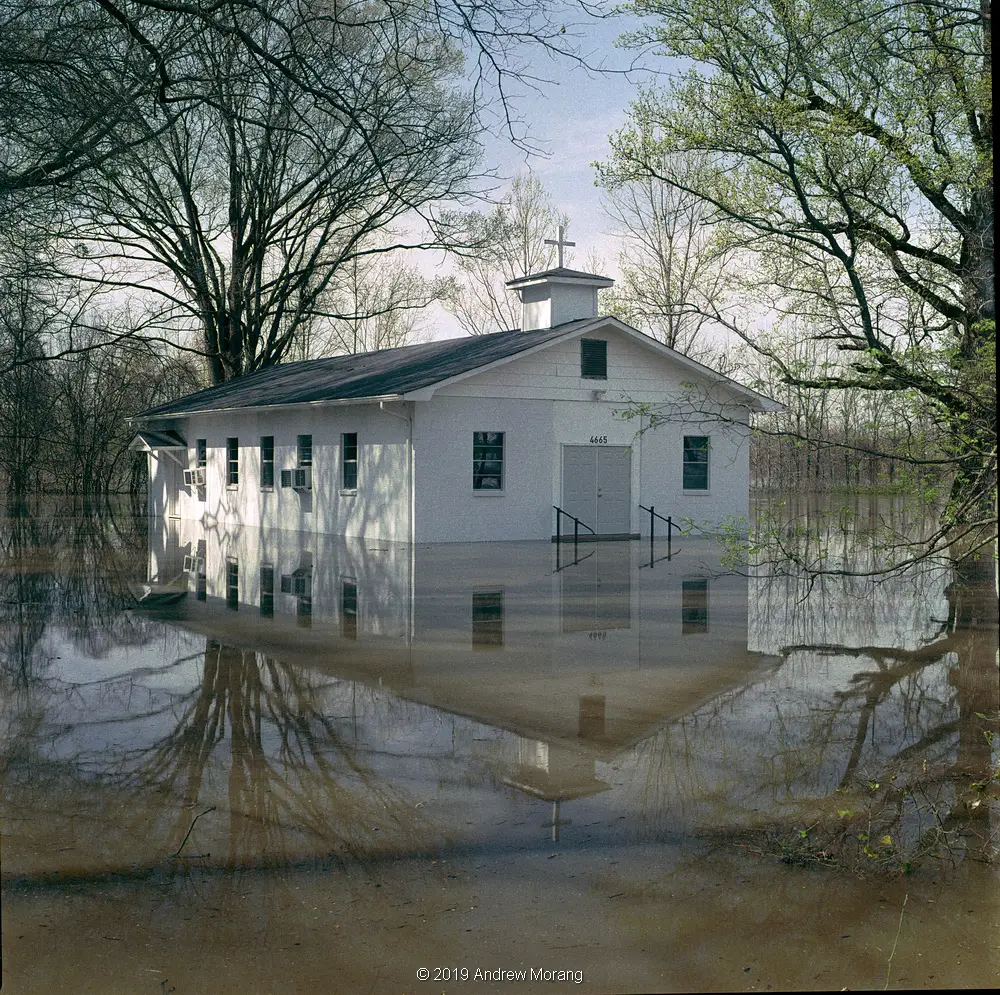
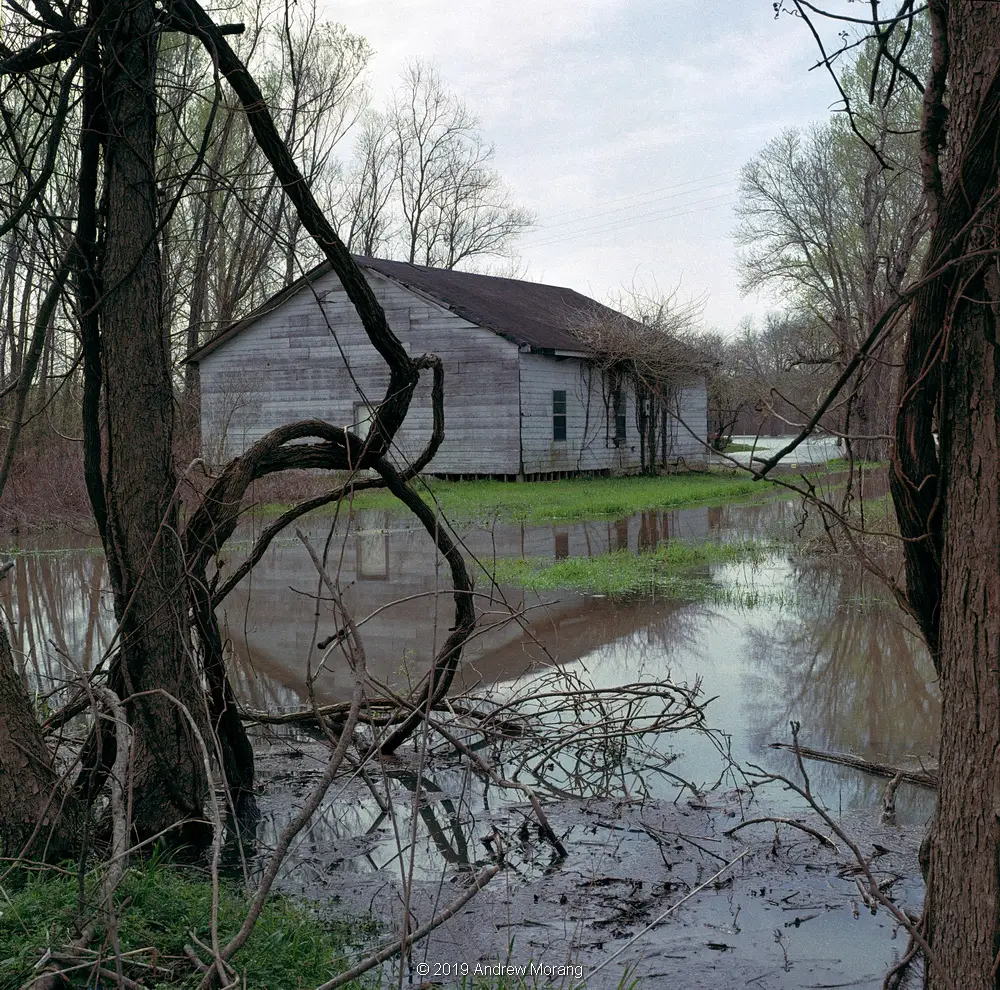
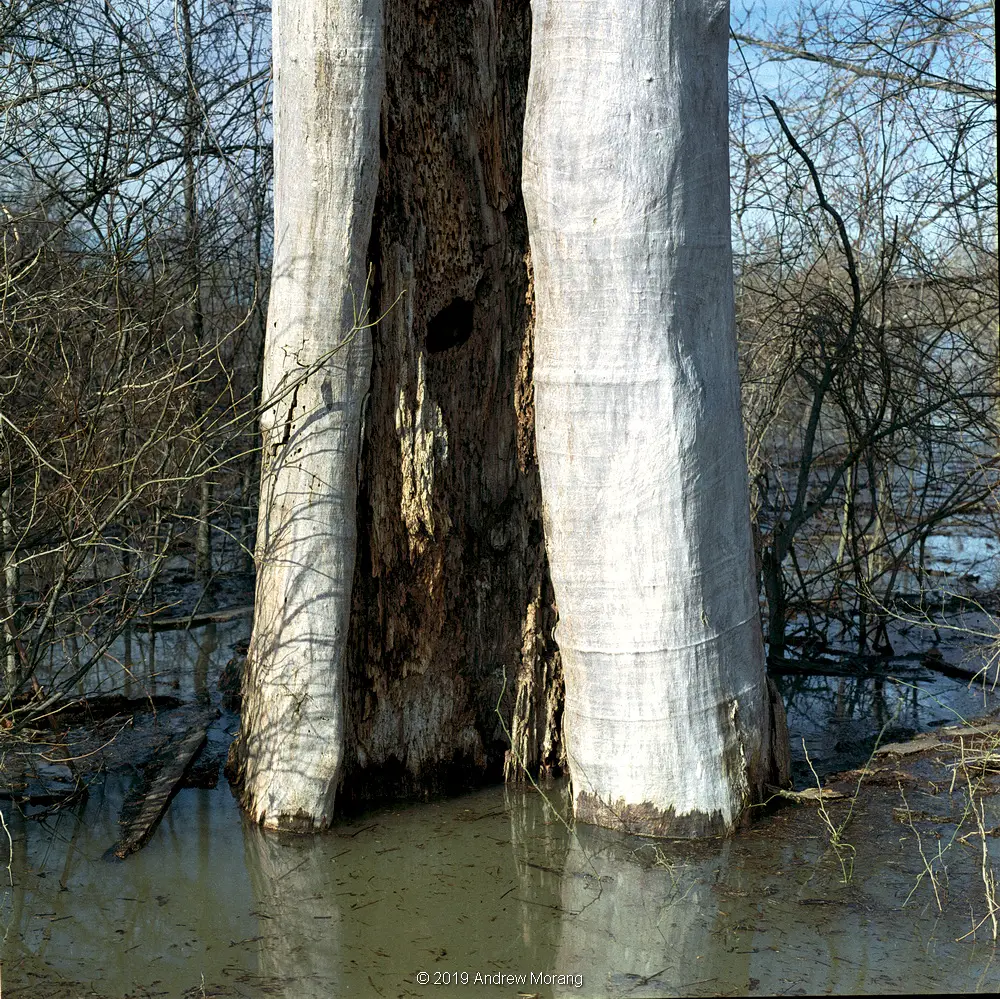
Floweree Road, north of the town of Redwood, passes through farms and some woodlands. With water on both sides, small animals like raccoons and possums have a high mortality from impact by cars and trucks. Surprisingly, I did not see any alligators. My wife and I saw vultures eating a dead wild hog. The snakes are out, too, and I almost stepped on a couple when setting up my tripod. I use an old Crown No. 4 wood tripod, whose legs can go in the water.
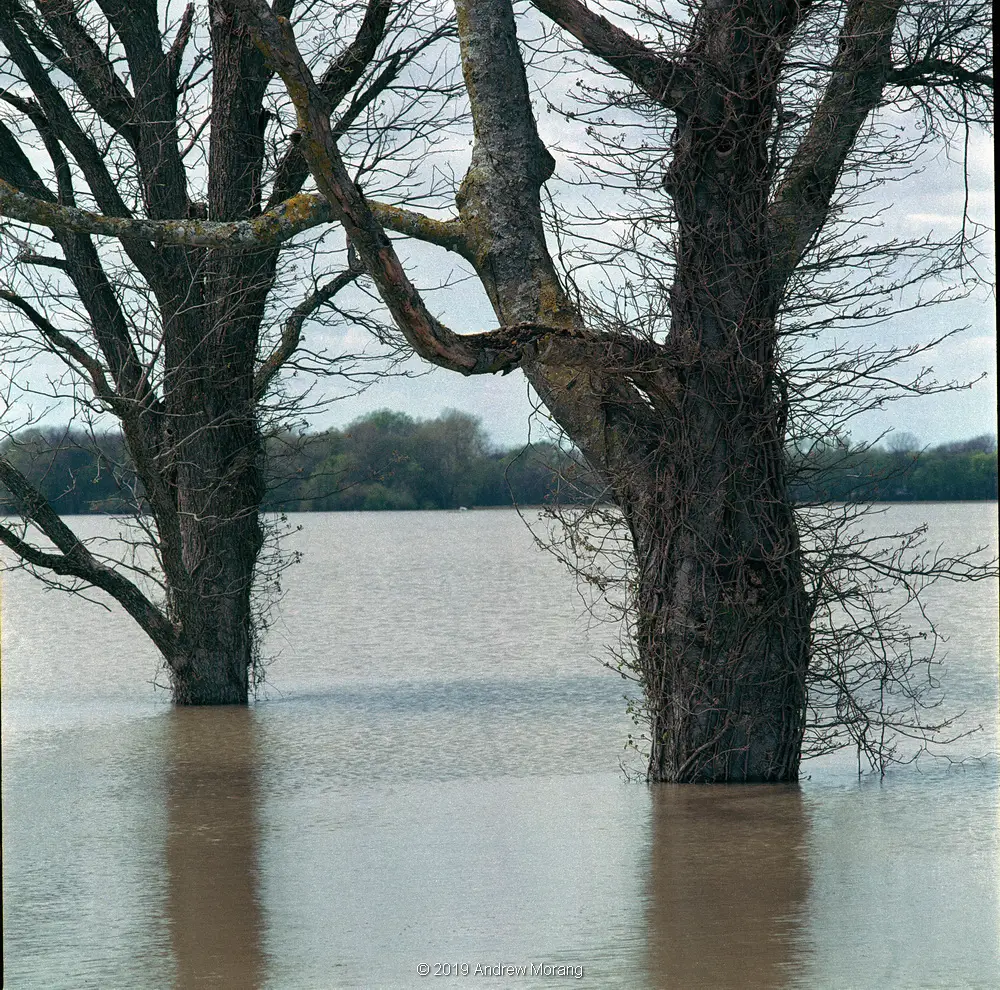
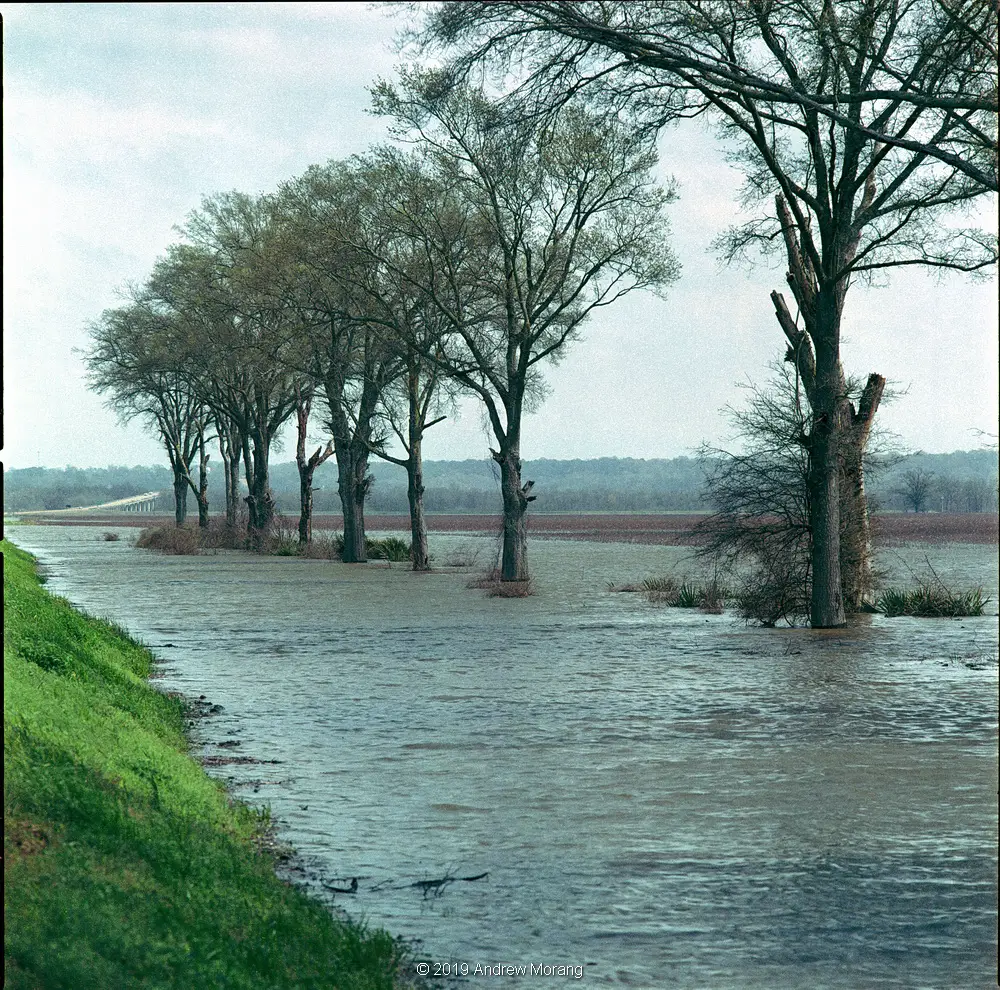
I met a gent who is entering his fifth month without electricity. He paddles a boat from his house to the road. When he first moves his boat, he uses his shotgun on the snakes that emerge from beneath. Last week, an alligator killed his dog.
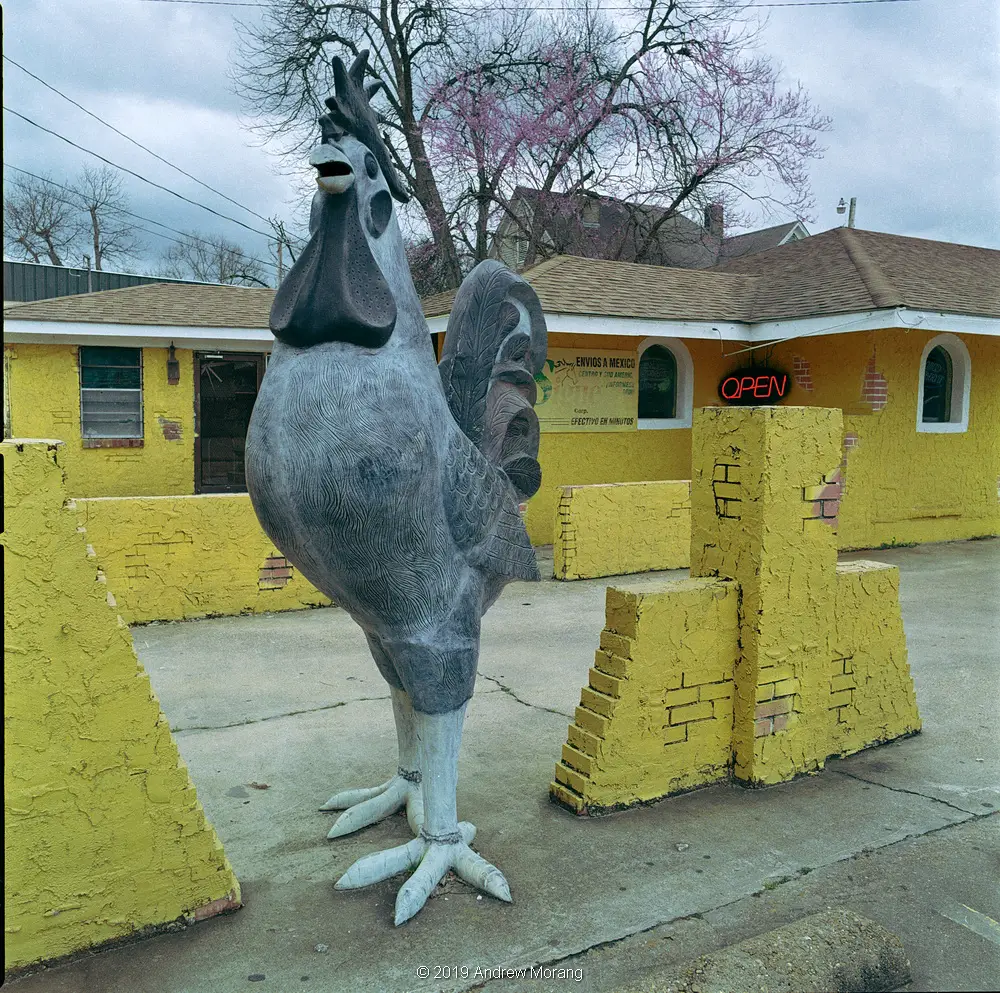
Well, I could not resist, Yazoo City has a big chicken (Chickenzilla?). He graciously posed for a portrait. I suppose it is pertinent because poultry is Mississippi’s major agricultural product, followed by forestry products and soybeans.
The end
I still like Ektar 25 film, but it has been gone from the market for two decades and it is time to move on. For black and white, I am still using my stock of long-frozen Kodak Panatomic-X film, my favorite. But realistically, with medium format cameras, grain is not an issue. Hasselblad camera lenses are superb, but that is well-established and you readers know that. I almost always use my Hasselblad on a tripod with the mirror up to reduce vibration. The need to set up makes me slow down and compose carefully. But with a higher-speed film, I could hand-hold, so that is where I should experiment next.
Thank you all for reading. Keep supporting film photography and 35MMC. Follow your passion, explore, record. You can follow my photographic wanderings at: https://worldofdecay.blogspot.com.
I have written about Mississippi before here in 35MMC re. this Hasselblad and my Texas Leica.
Update March 2021:
A friend sent me some more 120 Ektar 25, which I used in and around Vicksburg (please click the link).
Share this post:
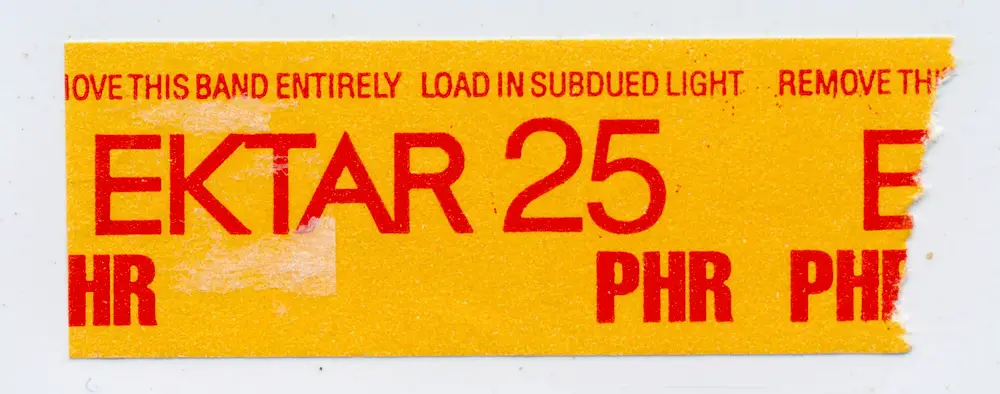








Comments
John Haney on Kodak Ektar 25 – Living in the Past, a Hasselblad, and Flooding in Mississippi – by Andrew Morang
Comment posted: 15/06/2019
I have 5 in the freezer.
Looking forward to using them in a Mamiya 645 1000s & a Bronica ETRS.
I'm not sure I can move on if for no other reason than to hold in memory what this film could once do.
Kodak Ektar 25, and Agfa Ultra 50: I've never seen anything like them.
There are some prints I have not re-looked at in years, but the original impression they made on me, on the day I first saw them, is still fresh in my mind.
If Kodak can bring out an Ektar 100 (successor to the original Ektar 125) then they certainly can re-introduce an Ektar 25, or introduce an Ektar 50.
I don't think anyone using Ektar 100 today, but who by reason of their birth date never had the opportunity to use fresh Ektar 25, could, or would, fail to appreciate and use, a re-introduced Ektar 25.
It would sell !
Terry B on Kodak Ektar 25 – Living in the Past, a Hasselblad, and Flooding in Mississippi – by Andrew Morang
Comment posted: 15/06/2019
Zvonimir on Kodak Ektar 25 – Living in the Past, a Hasselblad, and Flooding in Mississippi – by Andrew Morang
Comment posted: 15/06/2019
Comment posted: 15/06/2019
Pearson P on Kodak Ektar 25 – Living in the Past, a Hasselblad, and Flooding in Mississippi – by Andrew Morang
Comment posted: 16/06/2019
Mike Ramirez on Kodak Ektar 25 – Living in the Past, a Hasselblad, and Flooding in Mississippi – by Andrew Morang
Comment posted: 20/06/2019
Comment posted: 20/06/2019
Brett on Kodak Ektar 25 – Living in the Past, a Hasselblad, and Flooding in Mississippi – by Andrew Morang
Comment posted: 20/06/2019
Comment posted: 20/06/2019
5 Frames (oops, 6) in Mississippi with 35mm Kodak Ektar 25 film in a Spotmatic by Andrew Morang - 35mmc on Kodak Ektar 25 – Living in the Past, a Hasselblad, and Flooding in Mississippi – by Andrew Morang
Comment posted: 19/05/2020